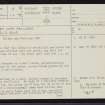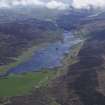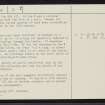Pricing Change
New pricing for orders of material from this site will come into place shortly. Charges for supply of digital images, digitisation on demand, prints and licensing will be altered.
Eilean Nam Faoileag
Fortified Island (Medieval), Hunting Lodge (Medieval)(Possible)
Site Name Eilean Nam Faoileag
Classification Fortified Island (Medieval), Hunting Lodge (Medieval)(Possible)
Alternative Name(s) Loch Brora
Canmore ID 6491
Site Number NC80NE 8
NGR NC 8560 0600
Datum OSGB36 - NGR
Permalink http://canmore.org.uk/site/6491
- Council Highland
- Parish Clyne
- Former Region Highland
- Former District Sutherland
- Former County Sutherland
NC80NE 8 8560 0600.
(NC 8560 0600) Eilean nam Faoileag (NR)
OS 6"map, (1964)
(Classified as artificial island). The NSA (1845) states that the island is artificial and sited for defence. It was divided into two parts, one half for "lodgings in time of war, the other half laid out .... as a garden."
The island is bounded by a wall rising perpendicularly from the surface of the water, access being gained by two stairs on the S and E sides.
New Statistical Account (NSA, written by Rev G Mackay) 1845.
Eilean nam Faoileag is a small island formed of boulders and said to be artificial. No sign of a building remains on the level top, but along the E face for 30 to 40ft are the remains of a retaining wall some four or five feet high. On the E and W faces near the N end, two built recesses probably indicate the position of the stairs mentioned in the NSA (1845). At the S end a circular depression may mark the site of a well. Gordon (1813) states that the island appears to have been occupied as a hunting seat in the 17th century.
R Gordon 1813; RCAHMS 1911, visited 1909.
(Classification amended to fortified island). Eilean nam Faoileag (name verified) is bounded by a retaining wall up to 1.3m high but generally reduced to footings protruding through the tumble. It measures 42.0m N-S by 28.0m EW. Of the two recesses on the E and W sides the latter, at least 11.0m long, is almost certainly a boat noust; there is no trace of the stairs noted by NSA. No buildings remain on the islet which is mainly turf-covered,with some trees.
The islet is wholly or partly artificial and, by the strength of the retaining wall and the nature of its position, defensive.
The angularity of the wall suggests an historic context rather than a dun or crannog. It may be a 17th century hunting seat (RCAHMS 1911) but no further evidence can be gained locally.
Revised at 1/10,000.
Visited by OS (E G C) 16 July 1961 and (J B) 14 November 1975.
Field Visit (25 September 1909)
47. Island, Loch Brora. Situated on Loch Brora, towards the S. end, is a small island formed of boulders, said to be artificial, named on the O.S. map ‘Eilean nam Faoileag’. No signs of building remain visible on the level top, but along the E. face for 30' or 40' are the remains of a retaining wall some 4' to 5' high. On the E. and W. faces, near the N. end, two built recesses probably indicate the position of the stairs mentioned in the New Statistical Account. At the S. end a circular depression may mark the site of the well. The island appears to have been occupied by the Earl of Sutherland as a hunting seat in the 17th century. Sir Robert Gordon thus mentions it: ‘In Loch Broray there is ane ileand where the Erle of Southerland has a delectable habitation and pleasant for hunting of reed deir and roes in the woods on both syds of the laik’.
See Gordon, p. 5 ; Stat. Acct., x. p. 303; New Stat. Acct.
Suth., etc., xv. p. 155.
OS 6-inch map: Sutherland Sheet xcvii.
RCAHMS 1911, visited (AOC) 25th September 1909.






















